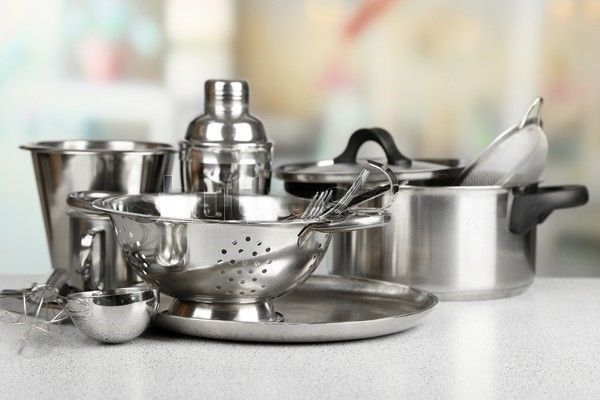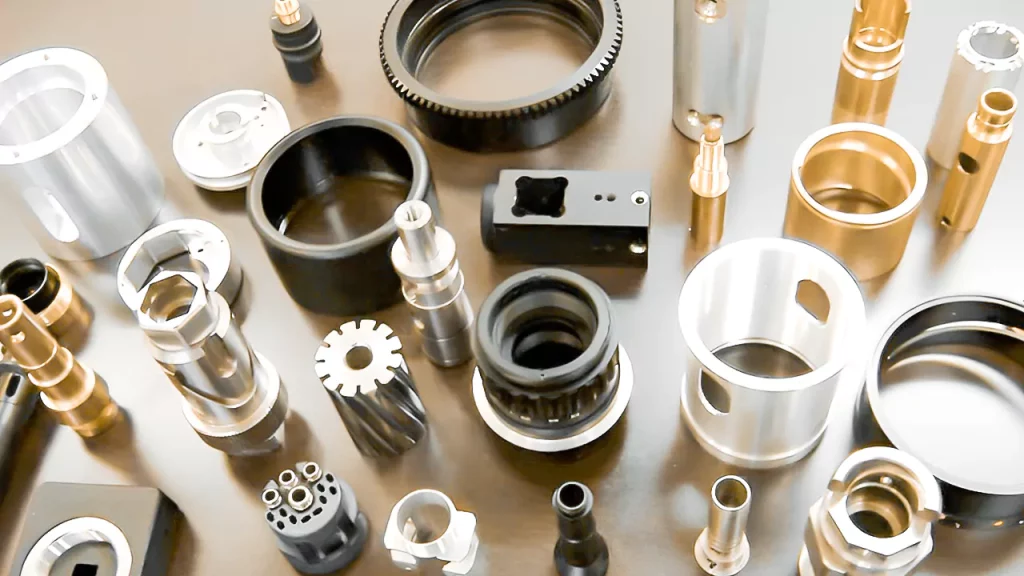Introduction
When designers consider strength and durability in their designs, steel and titanium are frequently the first materials that spring to mind. These two metals are utilized in a number of applications and are available in a wide range of alloys. Unless you thoroughly examine their chemical and structural characteristics, the distinction between steel and titanium might not be immediately apparent.
What is Titanium?
Titanium is a thin, silvery-gray metal that is lightweight, low density, and high strength. It is also resistant to corrosion caused by saltwater, aqua regia, and chlorine.

Titanium ore
Aluminum, iron, and a number of other elements can all be alloyed with titanium.
The corrosion resistance and strength-to-density ratio of titanium and titanium alloys make them suitable for usage in a variety of industries, including aerospace, marine, industrial, consumer, and architectural.
Although titanium is difficult to machine, CNC milling manufacturing is nevertheless a useful and rapid turn production technology to produce a variety of precise titanium machined components. Grades 2 and 5 titanium are two common grades that may be worked with (Ti-6Al-4V).
What is Steel?
Steel is one of the most popular alloys; it is normally an iron alloy with a little amount of carbon added to increase its strength and resistance to fracture. Steel is a substance that is thick, hard, magnetic, and resistant to high temperatures; nevertheless, most steels are prone to corrosion, which is addressed by stainless steel. Steel is used often in construction, structures, infrastructure, transportation, equipment, electrical appliances, and vehicles because of its inexpensive cost, high tensile strength, and working qualities.

Steel beams
Numerous distinct steel alloys, such as 4130 steel, 4140 steel, A36 steel, etc., are created as a result of the metal's variable carbon and other alloying element content, which both enhances the material's quality and provides each alloy its own special features.
Differences Between Titanium and Steel.
The application dictates whether steel or titanium should be used. In order to aid with the identification of each metal, this section compares the mechanical and chemical characteristics of steel and titanium. The greatest comparison of these metals, however, is based on distinct kinds of alloys rather than generic information. The following are the key distinctions between titanium and steel that should be taken into account for each application.
Element Composition
When comparing titanium with steel, the elemental makeup is the first significant distinction. As previously mentioned, titanium is an element that occurs naturally and may be found in both pure and alloyed forms. The most typical titanium alloy that you'll come across is Ti 6-4, an alloy made of aluminum and vanadium.
Contrarily, steel does not occur in nature. Iron and carbon make up the majority of it, with various proportions of additional elements added to change the qualities according to the use. The technical characteristics of steel are therefore nowhere to be found. To get more particular information, you'll need to mention the alloy, such as stainless steel, high carbon steel, or a specific alloy like 4130, 4140, or A36.
Corrosion Resistance
Steel is less resistant to corrosion and rust than titanium. However, there are a number of steel-and-metal alloy variations that exhibit outstanding rust resistance. Steel has a higher tendency to rust due to the iron it contains, however there are many other steel alloys that contain other metals that have good corrosion resistance. Due to its extremely high chromium content, stainless steel is the finest choice when it comes to rust resistance.
On the other hand, pure titanium possesses exceptional resistance to rust and corrosion, particularly from liquids. This is the reason why the metal is frequently used in the construction of ships since it can withstand acids, chemicals, and even sea water. However, it is difficult to locate and much more difficult to create pure titanium.
Since titanium alloys contain other mixed metals, many components and things made of titanium are really composed of titanium alloys, which aren't always completely resistant to rust and corrosion. However, titanium alloys continue to offer greater resistance to rust and corrosion than other metal alloys, making them a popular choice for items that will be utilized in moist environments.
Weight
Titanium's low density and strong strength-to-weight ratio serve as its distinguishing qualities. Because of this, this metal is a popular option for CNC machining and manufacturing in the aerospace sector and other fields where weight reduction without a loss in strength is necessary. Steel alloys, on the other hand, are often strong and long-lasting but are heavier. They are the ideal option for situations where weight is not a major design consideration.
Mechanical Properties of Steel vs Titanium
Materials are typically used for a variety of applications because they provide desired combinations of mechanical properties. Engineers must consider material qualities since they are essential for structural applications. The characteristics listed below will be used to compare the two alloys.
- modulus of elasticity
- tensile yield strength
- Elongation
- Hardness
I. modulus of elasticity
A measure of a material's flexibility is the modulus of elasticity, often known as Young's modulus. It defines how easily a material may be bent or warped without undergoing plastic deformation and is frequently a useful indicator of a material's general elastic response. Since titanium has a relatively low elastic modulus, it is likely to bend and deform quickly. The fact that titanium clogs mills and likes to assume its original shape is one of the reasons it is challenging to manufacture.
Contrarily, steel can be easily machined and is well suited for applications like knife edges since it will shatter under tension rather than bending. This is because steel has a significantly greater elastic modulus than other materials.
II. Tensile yield strength
It turns out that steel is generally stronger than titanium when comparing the tensile yield strengths of steel and titanium. This disproves the widespread belief that titanium is more useful than other metals and demonstrates the superior strength of steel. Despite having strength that is only on par with steel, titanium is one of the strongest metals per unit mass since it is just half as heavy.
Steel, on the other hand, is the material of choice when overall strength is a concern since certain of its alloys outperform all other metals in terms of yield strengths. Steel is the best option for designers who are just concerned with strength; however, titanium is the best option for designers who are also interested in strength per unit mass.
III. Elongation
In a tensile test, the elongation at break is calculated by dividing the beginning length of the test specimen by the length immediately before to fracture, then multiplying the result by 100 to obtain a percentage. Large elongation at break indicates that the material "stretches" more, or is more likely to exhibit greater ductile behavior prior to breaking.
One such substance that extends almost half its length before breaking is titanium. The fact that titanium pulls and deforms rather than chipping off is another factor contributing to its difficulty in being machined. There are many different types of steel, but they all typically have a low elongation at break, making them tougher and more likely to fracture brittlely when under stress.
IV. Hardness
Hardness is regarded as a relative quality that describes how a material reacts to impacts such as scratching, denting, and etching that are applied to its surface.
An indenter device is used to determine a metal's hardness. Although titanium is tough, it is not as tough as steel. This does not imply that titanium deforms readily.
On the other hand, titanium generates a strong oxide coating that shields the metal from dents. Steel is tough and does not nick readily. Because of this, it can be used for applications that call for exposure to challenging circumstances.
Common Applications of Titanium
There are several applications for titanium, ranging from everyday goods to military vessels.
Due to the metal's excellent resistance to corrosion, it is particularly well-liked for items that will be utilized in severely corrosive conditions. It is utilized in the maritime, oil, and gas industries, as well as in sports.
In racing automobiles, titanium is frequently utilized as a cockpit protector due to its durability and strength. It has proven to be highly successful in creating halo structures that deflect debris and shield the driver in the event of an accident. Titanium is the finest metal to choose if you need something incredibly durable and dependable because it has saved many lives throughout the years. Another factor that makes titanium such a popular choice for racing vehicles is the fact that it is very lightweight given its strength. These automobiles need to be as light as possible, and the only metal that can provide both exceptional strength and minimal weight at the same time is titanium.
Furthermore, titanium is commonly utilized in prostheses. A variety of surgical procedures can use the metal because it adheres nicely to bone, particularly in joint replacements. Due to the metal's strong biocompatibility, it is also utilized in toe implants, eye implants, and dental implants.

dental implants
Common Applications of Steel
Steel is one of the most frequently used building materials in the world and has many uses in engineering, construction, auto manufacture, and agriculture. Steel alloys are simple to work with and may be enhanced with other metals to bring forth certain qualities that make them useful for a wide range of applications. Steel is reportedly employed in the production of more than half of all goods, which should give you a good indication of how frequently this metal alloy is utilized.
Stainless steel, an alloy of steel made of iron, chromium, and other elements, is one of the types of steel that the majority of people use on a regular basis. Bottles, pans, pots, and other cooking equipment are frequently made of that type of steel because it is the most rust-resistant.

Kitchenware
Additionally, bicycle frames can be made from steel or titanium. Steel is typically a superior choice for bike frames since it is more affordable, stronger, and comfortable to ride. Though often lighter than steel ones, titanium frames aren't quite as durable.
Steel has a high tensile strength comparable to titanium, but it is more energy-efficient and hence more affordable to produce.
Steel is a metal alloy that permeates every aspect of people's life, including the refrigerator where you keep your food and the structure you reside in.
Conclusion
The decision to choose titanium or steel is not as straightforward as it first appears to be. One or the other is preferred depending on the particular requirements of the design. It is advisable to be aware of the key characteristics of both materials before making your ultimate decision.








